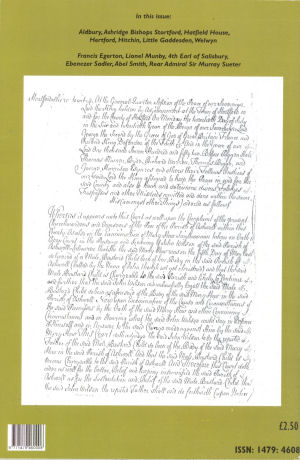|
|
Herts Past and Present Hertfordshire Association for Local History Spring 2009 - No 14 |
|
|
In this issue Aldbury, Ashridge, Bishops Stortford, Hatfield House, Hertford, Hitchin, Little Gaddesden, Welwyn Frances Egerton, Lionel Munby, 4th Earl of Salisbury. Ebenezer Sadler, Abel Smith, Rear Admiral Sir Murray Sueter
|
Brief Guide to Sources: Bastardy Records - by David Short |
|
|
Lionel M. Munby: 1918-2009: An Appreciation - by David Short |
||
|
Supporting the poor; Little Gaddesden 1780-1834 - by Francis Kerner |
||
|
Poor law administration in Little Gaddesden changed during the course of fifty years from a laissez-faire approach under Francis Egerton, the 3rd Duke of Bridgewater, to a much more hands-on style with his successor in 1803. This examination of the transition from an open to a closed parish is enlivened with a wide variety of individual cases. An independent vestry under the 'Canal' duke The 1802 revaluation and a new rate Financial Management Medical Provision Charity Settlement examinations and removal orders, 1811-31 A hastily arranged wedding The case of the war orphans From an 'open' to a 'close' parish |
||
|
Hertfordshire and the General Strike of 1926 - by Nigel Agar |
||
|
The story of the general strike in this county tells us a bit about both the strike itself and prevailing local political attitudes at the time. One might imagine that the strike had little impact on Hertfordshire which is neither a mining area nor particularly industrial. That would be wrong. Even in the 1920s Hertfordshire was home to many London commuters whose normal work routine was made quite impossible when the railways were taken out. A transport strike Fatal accident at Bishops Stortford Support for the strike General opinion |
||
|
Welwyn Workhouse - by M. S. Edwards |
||
|
Here Sue Edwards takes us inside Welwyn workhouse for a look at the care taken in dressing, feeding and clothing the inmates - of all generations - in 1907 and earlier. Fortunately the building itself survives and its present owners have made some interesting discoveries about the interior layout of the building. |
||
|
Ebenezer Sadler, Receiver General to the Cecils - by Paul Barton |
||
|
Paul Barton here looks at the role of Ebenezer Sadler; Receiver General in the late seventeenth-century to the 4th Earl of Salisbury. The earls conversion to Catholicism and support of James I led to arraignment and imprisonment in the Tower for treason for him but an opportunity for promotion for Ebenezer Sadler Further problems for the earl - marriage to an under-age city heiress, a dispute over her dowry, the death of his father in 1683, and his own early death leaving an under-age heir - entailed a great many extra responsibilities for the estate 50 servants, particularly the Receiver General who rose to a position of great influence. Here we look at his management of the family's financial and legal affairs and the administration of their Hertfordshire estates. Estate administration The Cecil family and their estate Executor, guardian, trustee and advisor The Glorious Revolution Changing family fortunes Accounting problems Administration of the estate's manors |
||
|
Crouchfield: A history of the Herts Training School, 1857-1982 - by Dorothy Abel Smith |
||
|
In March 1982 the Herts Training School at Chapmore End, near Hertford, closed its doors after 125 years. A Reformatory School for Juvenile Offenders was founded there in 1857 and over the years saw many changes. The author's family devoted much time to the school so she wanted to record this piece of industrial history before it was forgotten. Early History The School is Built The School Opens Funding The School Management Committee The Army Cadet Unit and Two World Wars Change and the Children and Young Persons Act 1969 The Crouchfield Trust A book, Crouchfield: A history of the Herts Training School, is available from HALS. |
||
|
Also editorial, news items, dates for the diary, and book reviews |



